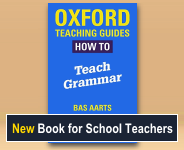Glossary: cohesion
Explanation
Cohesion refers to the grammatical relationships that exist within a text between words, phrases, etc. When we talk only of the semantic links, i.e. the meaning links, we speak of coherence.
A text has cohesion if it is clear how the meanings of its parts fit together. Cohesive devices can help to do this.
In the example, there are repeated references to the same thing (shown by the different combinations of bold, capitals, underlining and asterisks), and the logical relations, such as time and cause, between different parts are clear.
A visit has been arranged for YEAR 6, to the Mountain Peaks Field Study Centre, leaving school at 9.30am. This is an overnight visit. The centre has beautiful grounds and *a nature trail*. During the afternoon, THE CHILDREN will follow *the trail*.
Englicious contains many resources for English language in schools, but the vast majority of them require you to register and log in first. For more information, see What is Englicious?

